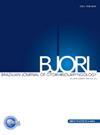A novel cochlear implant assessment tool: Audiometric and speech recognition analysis
IF 1.7
4区 医学
Q2 OTORHINOLARYNGOLOGY
引用次数: 0
Abstract
Objective
To compare the results of Pure Tone Audiometry (PTA) and speech recognition, of users of Cochlear Implant (CI) between CLABOX with Direct Audio Input (DAI) and the Sound Booth (SB).
Methods
Fifty individuals with CIs, 33 adults and 17 children, were included. Speech recognition tests in noise fixed and adaptive were applied with the Hearing in Noise Test (HINT), Ling test, and PTA, in the SB (in free field) and in CLABOX.
Results
For speech recognition in noise, averages were better in the CLABOX; for PTA, they were higher in the CLABOX; and for Ling test, there was no significant change in the categories between SB and CLABOX. The fixed noise were higher in the CLABOX (88.3%) than in the SB (78.9%), p-value < 0.001. In the HINT with adaptive noise, the results were significant (p-value = 0.007); the S/N ratio was 2.14 dB in the CLABOX and 3.42 dB in the SB. For the four-tone average, the average thresholds for the CLABOX and the SB were 29.8 dB and 23 dB, respectively (p-values < 0.001).
Conclusion
CLABOX was an effective tool to evaluate the PTA and speech recognition tests when compared to the conventional evaluation with a SB in the CI user population.
求助全文
约1分钟内获得全文
求助全文
来源期刊

Brazilian Journal of Otorhinolaryngology
OTORHINOLARYNGOLOGY-
CiteScore
3.00
自引率
0.00%
发文量
205
审稿时长
4-8 weeks
期刊介绍:
Brazilian Journal of Otorhinolaryngology publishes original contributions in otolaryngology and the associated areas (cranio-maxillo-facial surgery and phoniatrics). The aim of this journal is the national and international divulgation of the scientific production interesting to the otolaryngology, as well as the discussion, in editorials, of subjects of scientific, academic and professional relevance.
The Brazilian Journal of Otorhinolaryngology is born from the Revista Brasileira de Otorrinolaringologia, of which it is the English version, created and indexed by MEDLINE in 2005. It is the official scientific publication of the Brazilian Association of Otolaryngology and Cervicofacial Surgery. Its abbreviated title is Braz J Otorhinolaryngol., which should be used in bibliographies, footnotes and bibliographical references and strips.
 求助内容:
求助内容: 应助结果提醒方式:
应助结果提醒方式:


